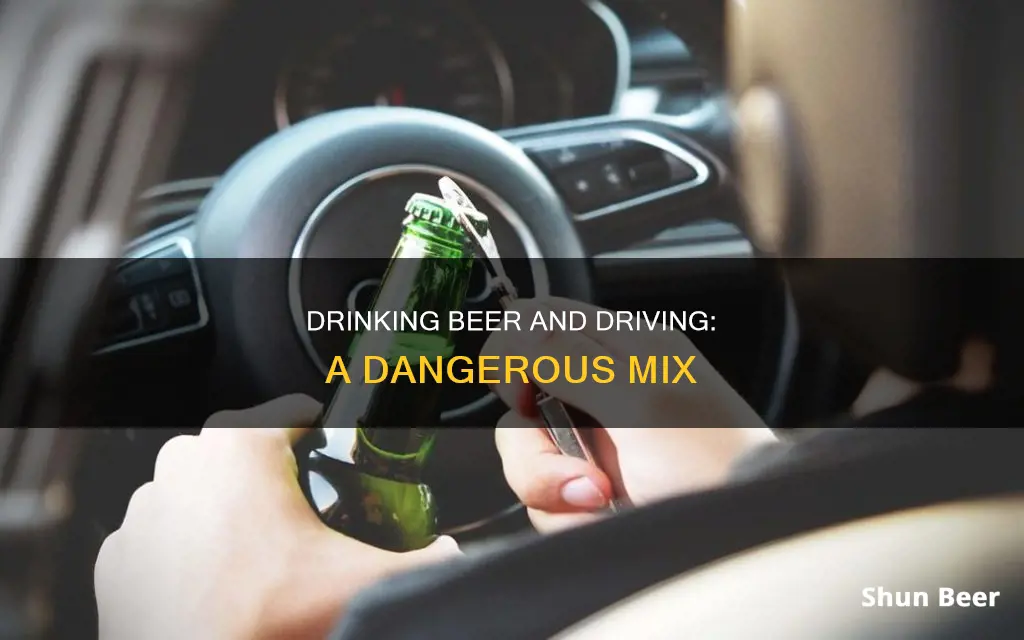
Drinking and driving is a serious offense with potentially life-altering consequences. Even a small amount of alcohol can impair your ability to drive safely, and you may not even realize the impact it is having on your judgment, coordination, and reaction time. While the legal Blood Alcohol Concentration (BAC) limit in most places is 0.08%, any amount of alcohol can affect your driving ability and result in a DUI charge if a police officer deems your driving ability to be impaired. The only sure way to avoid the risks of drinking and driving is to abstain from alcohol altogether or to make alternative arrangements for transportation.
| Characteristics | Values |
|---|---|
| Legal Blood Alcohol Concentration (BAC) limit | 0.08% |
| Number of drinks to reach the legal limit | 3-4 regular 12-ounce beers (5% alcohol by volume) in one hour for an 180-lb man; 2.5 for a 140-lb woman |
| Factors affecting BAC | Metabolic rate, weight, gender, food intake, prescription drugs, over-the-counter products |
| Impact of 1 drink (BAC of 0.02%) | Ability to multitask and track moving objects is affected |
| Impact of 2 drinks (BAC of 0.05%) | Coordination and reaction time are affected |
| Impact of 3-4 drinks (BAC of 0.08%) | Perception and concentration are affected |
| Impact of 5-6 drinks (BAC of 0.10%) | Information processing slows |
| Impact of 6+ drinks (BAC of 0.15%) | Information processing, perception, and coordination severely decline |
What You'll Learn
- Drunk driving is a negligent act that can lead to devastating consequences
- The effects of alcohol on driving abilities, including coordination and reaction time
- The “one drink an hour” rule and its effectiveness in maintaining legal BAC levels
- The impact of body composition, weight, and gender on alcohol metabolism and BAC
- The legal repercussions of drunk driving, including fines, jail time, and ignition interlock devices

Drunk driving is a negligent act that can lead to devastating consequences
Even a small amount of alcohol can significantly impact a person's driving ability and increase the risk of accidents and DUI charges. Alcohol impairs judgement, coordination, reaction time, perception, and concentration, all of which are crucial for safe driving. It is worth noting that impairment can occur even before a person starts to feel the effects of alcohol, and by the time they "feel" intoxicated, they are already well beyond the safe limit for driving.
The legal consequences of drunk driving can be severe. In the United States, driving with a blood alcohol concentration (BAC) of 0.08% or higher is illegal, and drivers can be charged with a DUI if they are found to be impaired by alcohol, even if their BAC is below the legal limit. The penalties for drunk driving can include steep fines, jail time, and the requirement to install an ignition interlock device in your vehicle.
The impact of alcohol on the body varies from person to person and is influenced by factors such as weight, gender, age, metabolism, and whether the person has consumed food or other substances. For example, a lower body weight results in faster absorption of alcohol into the bloodstream, leading to quicker intoxication. Additionally, women tend to have lower water content in their stomachs and lack certain enzymes used to break down alcohol, making them more sensitive to its effects.
The safest option is to refrain from drinking altogether if you plan to drive. If you intend to consume alcohol, it is essential to arrange alternative transportation, such as a designated driver, public transportation, or a rideshare service. By making responsible choices, you can help ensure the safety of yourself and others on the road.
The consequences of drunk driving can be devastating and far-reaching. It can lead to serious injuries, disabilities, and even fatalities. It shatters families, cuts short the lives of children and teens, and leaves loved ones permanently disabled or disfigured. The emotional and financial toll on the victims and their families can be immense, and the negligent actions of drunk drivers can have lifelong repercussions.
Lovastatin and Beer: A Safe Mix?
You may want to see also

The effects of alcohol on driving abilities, including coordination and reaction time
Alcohol is a depressant drug that slows down the activity of the central nervous system, including the brain. This can have a significant impact on your ability to drive safely. Even small amounts of alcohol can increase the risk of accidents and DUIs.
When drinking alcohol, you become impaired even before you start feeling "buzzed". This is what makes driving after drinking so dangerous—it affects your judgement about your level of sobriety. By the time you start feeling the effects, you are way beyond the point of being safe to drive.
1 Drink (~BAC of 0.02%)
Your ability to multitask and track moving objects is affected. You may have difficulty driving if you are also trying to follow directions from your GPS or hold a conversation with a passenger. You may also not notice other vehicles or pedestrians around you, leading to the "they came out of nowhere" cliché after a crash.
2 Drinks (~BAC of 0.05%)
Coordination and reaction time are affected. You may have difficulty steering or shifting. If you need to slow down, stop, change lanes, or turn quickly, you may not have enough time to do so before colliding with another vehicle.
3-4 Drinks (~BAC of 0.08%)
At this point, you are legally intoxicated, and your perception and concentration are affected. You may not be able to tell how fast you are driving or whether you are staying in your lane. You will very easily lose concentration, and you may forget to signal before changing lanes, fail to stop at red lights or stop signs, or miss your turn.
5-6 Drinks (~BAC of 0.10%)
Your information processing slows down. You may no longer be able to steer, accelerate, or brake correctly.
6+ Drinks (~BAC of 0.15%)
Information processing, perception, and coordination severely decline. You may no longer accurately see or hear what is happening around you. This is why drunk drivers can get into accidents and keep driving without realizing they hit anything, despite injuries or damage to their vehicles.
Drinking Beer and Taking Bactrim: What You Need to Know
You may want to see also

The “one drink an hour” rule and its effectiveness in maintaining legal BAC levels
The "one drink an hour" rule is a common misconception that suggests consuming no more than one standard drink (typically defined as 12 ounces of beer, four ounces of wine, or 1-1/4 ounces of 80-proof distilled spirits) over the course of an hour will keep your Blood Alcohol Concentration (BAC) under the legal limit of 0.08%. While this rule seems reasonable, it may not be effective for everyone due to variations in body composition, chemistry, and metabolism.
The effectiveness of the "one drink an hour" rule in maintaining legal BAC levels depends on several factors. Firstly, it's important to understand that the legal limit for BAC is set at 0.08%, and this limit may vary depending on location and individual factors such as age. The "one drink an hour" rule aims to keep an individual's BAC below this threshold. However, it's crucial to recognize that every individual has a unique relationship with alcohol metabolism and digestion. Factors such as body composition, weight, height, body fat, and metabolism play a significant role in how quickly alcohol is processed by the body.
Additionally, different alcoholic beverages can have varying effects on individuals. Hard liquor, for example, may induce a "drunker" feeling faster compared to beer or wine. It's worth noting that the legal limit for BAC is not solely dependent on how intoxicated an individual feels but on their actual blood alcohol content. Therefore, relying solely on the "one drink an hour" rule may not be sufficient to ensure legal BAC levels.
Furthermore, it's important to consider that alcohol affects each person differently, and these effects can vary even for the same person on different occasions. Factors such as gender, mood, food intake, alcohol tolerance, physical condition, medication, and carbonation can all influence how quickly a person becomes intoxicated and their BAC levels. Therefore, the "one drink an hour" rule may not account for all the variables that contribute to BAC levels.
While the "one drink an hour" rule provides a general guideline, it's crucial to recognize its limitations. To ensure legal BAC levels, it's essential to consider individual factors and make informed decisions about alcohol consumption and driving. Understanding your body's unique response to alcohol and staying within the legal BAC limits are crucial for safe driving. If you plan on drinking, it's always best to err on the side of caution and avoid driving altogether.
Sprite vs Beer: A Healthy Alternative?
You may want to see also

The impact of body composition, weight, and gender on alcohol metabolism and BAC
Body composition, weight, and gender all have an impact on alcohol metabolism and BAC.
Body composition refers to the percentage of fat, bone, and muscle in a person's body. This can give a clearer picture of a person's physical health and fitness than their body weight alone, as muscle is denser than fat. For example, a person with a lot of muscle can weigh more than someone with a lot of fat, even though they have a lower body fat percentage and look leaner.
Body fat percentage is how much of a person's body is made up of fat versus bone and muscle. As a person's body fat percentage increases, so does their risk of developing various diseases, including cancer, heart disease, and diabetes.
Gender also plays a role in how the body processes alcohol. Women tend to have lower body weight and a higher body fat percentage than men, which can affect how quickly they metabolize alcohol. Additionally, women tend to have lower levels of an enzyme called alcohol dehydrogenase in their stomachs, which is responsible for breaking down alcohol in the body. This means that women may metabolize alcohol more slowly than men, leading to higher BAC levels.
Weight also influences alcohol metabolism and BAC. Heavier individuals tend to have higher body water content, which can dilute alcohol in the body and slow down its absorption. On the other hand, individuals with a higher percentage of body fat may absorb alcohol more quickly, as alcohol is more soluble in fat than in water.
It's important to note that other factors, such as genetics, age, and whether the person has been eating or drinking anything else, can also affect alcohol metabolism and BAC.
Beer and Gleevec: A Safe Mix?
You may want to see also

The legal repercussions of drunk driving, including fines, jail time, and ignition interlock devices
Drinking and driving is a dangerous combination that can lead to severe legal repercussions. While the specific penalties vary by state and jurisdiction, here is an overview of the potential legal repercussions of drunk driving, including fines, jail time, and ignition interlock devices:
License Suspension or Revocation
In all states, driving under the influence (DUI) of alcohol is illegal, and violating this law will likely result in a suspension or revocation of your driver's license. The duration of the suspension varies, with some states imposing a 30-day suspension for a first offense, while others may take away your driving privileges for a year or more. Repeat offenses or refusing to take a chemical test can lead to longer suspensions or even permanent revocation.
Fines and Fees
DUI convictions typically come with significant monetary fines. Even for a first offense, you can expect to pay at least $500 in fines, and these costs increase with subsequent offenses. Additionally, there are various fees associated with a DUI, such as license reinstatement and court fees, which can amount to several hundred or even thousands of dollars.
Jail Time
About half of the states mandate jail time for a first DUI conviction, typically ranging from one day to a week. For second and subsequent offenses, jail time becomes more common and the mandatory minimums increase. For example, a second DUI offense in New Jersey carries a minimum of 48 hours of jail time, while a third offense results in a minimum sentence of 90 days.
Ignition Interlock Devices (IIDs)
Many states require individuals convicted of drinking and driving to install IIDs in their vehicles. These devices are breathalyzers connected to the car's ignition system. The car will not start unless the driver provides an alcohol-free breath sample. IIDs may be mandatory for all offenders, including first-time offenders, or they may be required only for repeat offenders, depending on the state. The defendant is usually responsible for the costs of installing and maintaining the IID.
Other Consequences
Drunk driving can have far-reaching consequences beyond the legal realm. It may result in job loss, particularly for those in transportation or other licensed professions. It can also impact child custody arrangements, as the noncustodial parent can request a custody hearing and the court may determine that the child's safety is at risk. Additionally, drunk drivers may be ordered to undergo court-ordered alcohol addiction treatment and participate in substance abuse education or treatment programs.
In conclusion, the legal repercussions of drunk driving are severe and wide-ranging. It is essential to understand the risks and make informed decisions to ensure the safety of yourself and others.
Nursing and Non-Alcoholic Beer: What's Safe?
You may want to see also
Frequently asked questions
No. While one beer will usually keep you below the legal limit, any amount of alcohol can impact your ability to drive safely.
Alcohol negatively affects nearly every aspect of driving. Even one drink can affect your ability to multitask and track moving objects. Two drinks can affect your coordination and reaction time.
The legal Blood Alcohol Concentration (BAC) limit is 0.08%. However, any impairment behind the wheel is illegal. If you are under 21 years of age, the limit does not apply, and you can be arrested even with a lower BAC.







